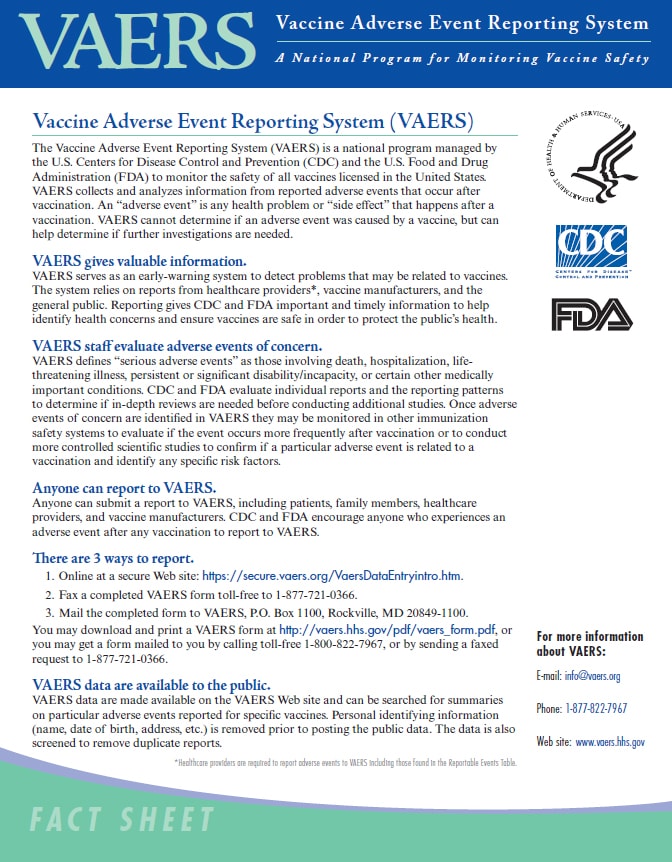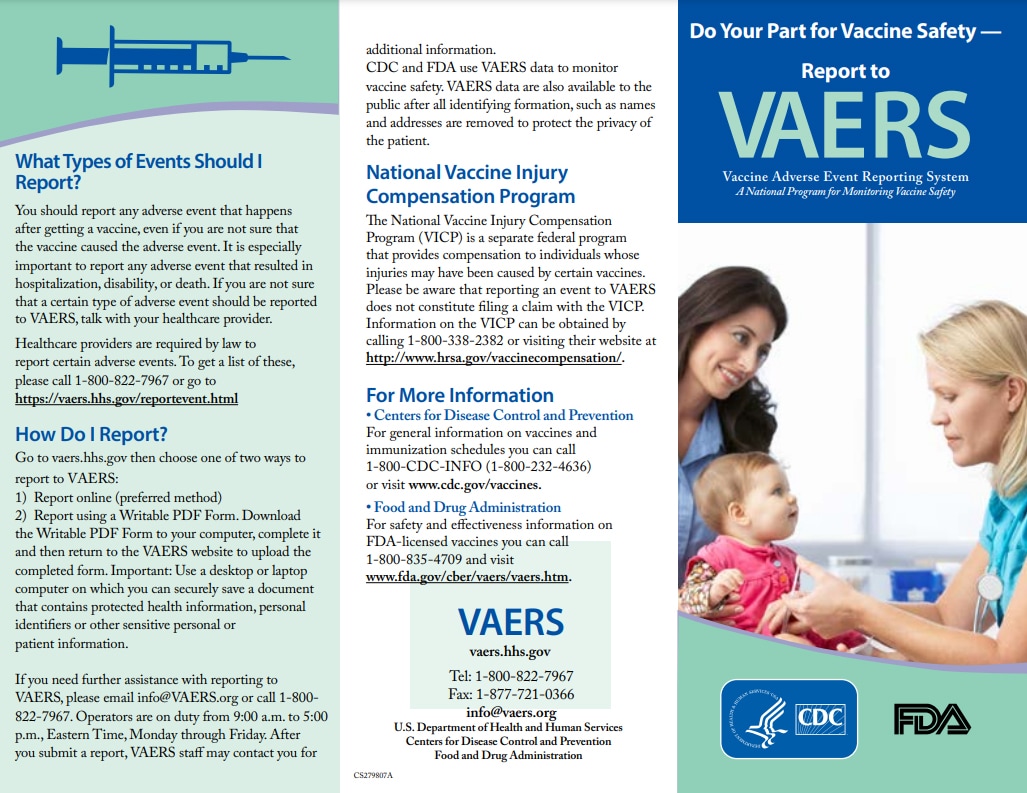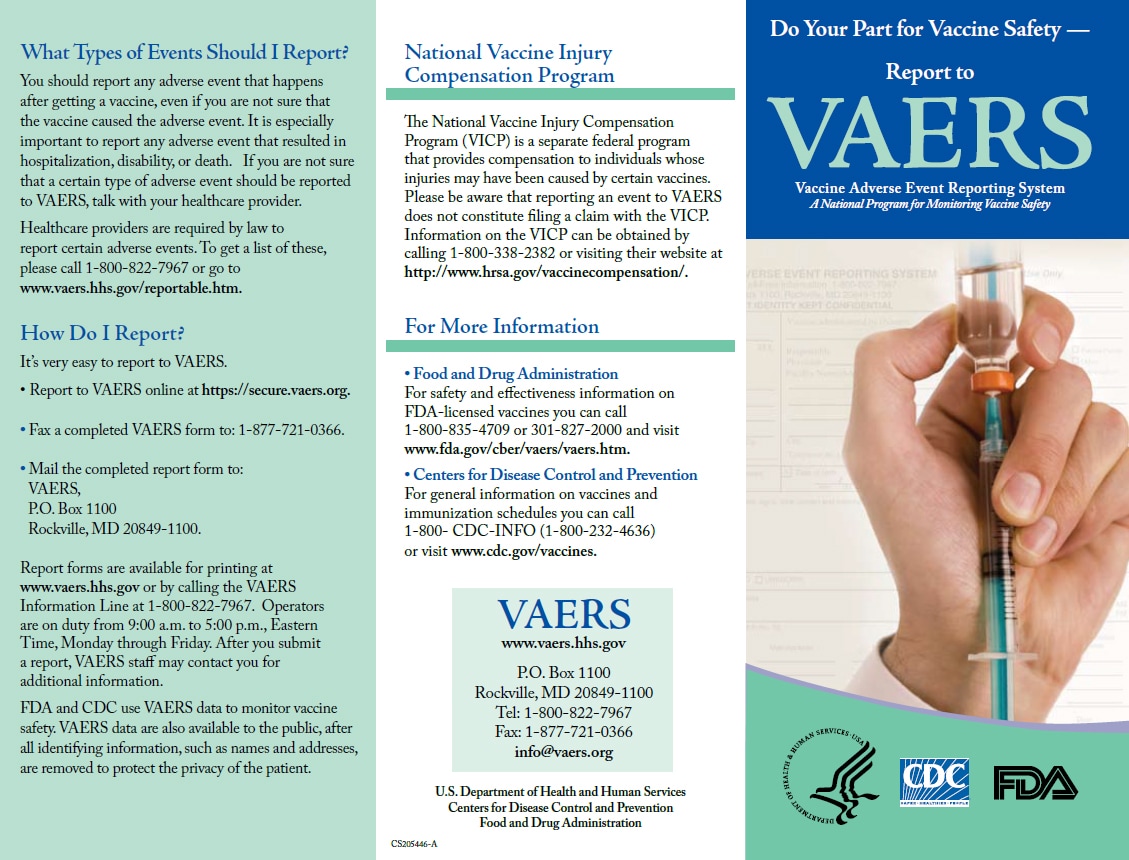At a glance
- The Vaccine Adverse Event Reporting System (VAERS) is one of several different systems CDC uses to monitor the safety of vaccines.
- VAERS accepts and analyzes reports of adverse events (any side effect or health problem after vaccination that is concerning to you, even if you are not sure if the vaccine caused the event).
- Anyone — patients, family members, healthcare providers and vaccine manufacturers — can submit a report to VAERS. Healthcare providers and vaccine manufacturers are legally required to report certain events after vaccination.
- A report to VAERS does not mean that a vaccine caused an adverse event.
- If it looks as though a vaccine might be associated with a health problem, CDC and FDA investigate further and take action if needed.
Overview
The Vaccine Adverse Event Reporting System (VAERS) is the nation's early warning system that monitors the safety of FDA-approved vaccines and vaccines authorized for use for public health emergencies. The system accepts and analyzes reports of possible adverse events after vaccination and is co-managed by CDC and FDA. The number of reports submitted varies each year. VAERS accepts reports regardless of seriousness or how likely the vaccine may have caused the adverse event.
Most VAERS reports involve mild side effects such as fever, arm soreness or mild irritability. Federal law defines reports of certain adverse events as serious reports. These include reports of the following after vaccination:
- Permanent disability.
- Hospitalization.
- Extension of an existing hospitalization.
- Life-threatening illness.
- Congenital (present at birth) deformity/birth defect.
- Death.
VAERS staff attempt to collect additional information from healthcare providers and clinicians about adverse events described in serious reports. While serious adverse events can happen after vaccination, they are rarely caused by the vaccine.
NEW! Expanded public access to VAERS data
On May 8, 2025, CDC and FDA expanded public access to VAERS data in the WONDER database (wonder.cdc.gov) and in VAERS downloadable files (vaers.hhs.gov) to provide a more complete picture of all reported adverse events following vaccination received. This enhancement is part of a broader CDC and FDA effort to improve transparency and access to vaccine safety data, while continuing to protect patient privacy.
- Prior to May 8, VAERS public data sets only included the first submitted VAERS report (or primary report) for a patient, vaccine and dose combination.
- VAERS public data sets now include all subsequent reports (or secondary reports) from the same or different reporters, for the same patient, vaccine, and dose combination.
- Based on this enhancement, in the downloadable data file, it will appear that additional reports have been added, but these are actually the subsequent or secondary reports that have previously not been included in the public data sets.
- It's important to note these new reports are related to already reported events and do not represent additional reports of adverse events.
What data VAERS collects
- The type of vaccine received.
- The date of vaccination.
- When the adverse event began.
- Current illnesses and medications.
- Medical history.
- Past history of adverse events following vaccination.
- Demographic information.
How data collection works
VAERS is a passive surveillance system, meaning it relies on people sending in reports of their experiences after vaccination.
How the data are used
CDC and FDA use VAERS reports to:
- Assess the safety of newly licensed or authorized vaccines.
- Detect new, unusual or rare adverse events that happen after vaccination.
- Monitor increases in known side effects, like arm soreness where a shot was given.
- Identify potential patient risk factors for particular types of health problems related to vaccines.
- Identify and address possible reporting clusters.
- Recognize safe-use problems and administration errors.
- Watch for unexpected or unusual patterns in adverse event reports.
- Serve as a vaccine safety monitoring system in public health emergencies.
- Add to and improve scientific literature and understanding of vaccine safety monitoring.
Signals
Patterns or an unusually high number of adverse events reported for a vaccine are called "signals." If they detect a signal, scientists may conduct further studies in VSD or CISA to find out if it represents an actual risk. CDC and FDA investigate further and act if needed.
Strengths and limitations of VAERS data
When evaluating VAERS data, it is important to understand the strengths and limitations.
Strengths
- VAERS accepts reports from anyone. This also allows VAERS to act as an early warning system to detect rare adverse events.
- VAERS collects information about the vaccine, the person vaccinated, and the adverse event. Scientists obtain follow-up information on serious reports.
- All data from the initial VAERS report (without identifying patient information) are available to the public.
Limitations
- VAERS is a passive reporting system, meaning that reports about adverse events are not automatically collected. Instead, someone who had or is aware of an adverse event following vaccination must file a report.
- Anyone can submit VAERS reports. Some reports can lack details or contain errors. After investigation, scientists find that most events reported to VAERS are not associated with vaccination.
- The number of reports submitted to VAERS can change in response to media attention and public awareness. Such changes in reporting can complicate interpretation of VAERS data.
- When more people hear about vaccine side effects, they may report any health outcomes they experience after vaccination.
- This increase in reporting can complicate detecting patterns of adverse events that should be further assessed in a strong, reliable data analysis system.
- Such increased reporting can also create the misconception that vaccines are dangerous, leading to fear and hesitation about vaccination.
- When more people hear about vaccine side effects, they may report any health outcomes they experience after vaccination.
- It is usually not possible to use VAERS data to calculate how often an adverse event occurs in a population.
- The number of people receiving a vaccine is usually not available (a notable exception was during the COVID-19 public health emergency when the number of doses of COVID-19 vaccine administered was reliably reported to CDC).
- The number of people receiving a vaccine is usually not available (a notable exception was during the COVID-19 public health emergency when the number of doses of COVID-19 vaccine administered was reliably reported to CDC).
- VAERS data alone cannot determine if the vaccine caused the reported adverse event. Establishing a causal relationship requires rigorous scientific assessment and consideration of multiple factors beyond just VAERS reports alone.



